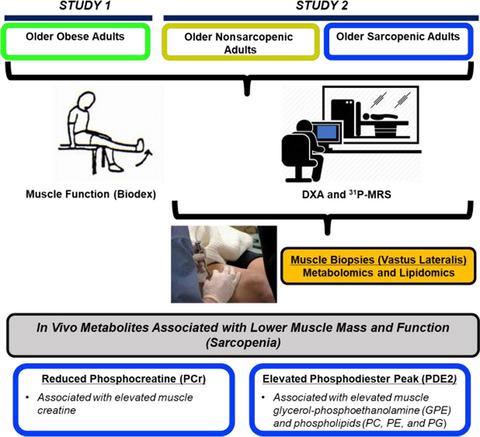当前位置:
X-MOL 学术
›
Aging Cell
›
论文详情
Our official English website, www.x-mol.net, welcomes your
feedback! (Note: you will need to create a separate account there.)
Older adults with sarcopenia have distinct skeletal muscle phosphodiester, phosphocreatine, and phospholipid profiles.
Aging Cell ( IF 8.0 ) Pub Date : 2020-05-28 , DOI: 10.1111/acel.13135 James Matthew Hinkley 1 , Heather H Cornnell 1 , Robert A Standley 1 , Emily Y Chen 2 , Niven R Narain 2 , Bennett P Greenwood 2 , Valerie Bussberg 2 , Vladimir V Tolstikov 2 , Michael A Kiebish 2 , Fanchao Yi 1 , Rick B Vega 1 , Bret H Goodpaster 1 , Paul M Coen 1
Aging Cell ( IF 8.0 ) Pub Date : 2020-05-28 , DOI: 10.1111/acel.13135 James Matthew Hinkley 1 , Heather H Cornnell 1 , Robert A Standley 1 , Emily Y Chen 2 , Niven R Narain 2 , Bennett P Greenwood 2 , Valerie Bussberg 2 , Vladimir V Tolstikov 2 , Michael A Kiebish 2 , Fanchao Yi 1 , Rick B Vega 1 , Bret H Goodpaster 1 , Paul M Coen 1
Affiliation

|
The loss of skeletal muscle mass and function with age (sarcopenia) is a critical healthcare challenge for older adults. 31‐phosphorus magnetic resonance spectroscopy (31P‐MRS) is a powerful tool used to evaluate phosphorus metabolite levels in muscle. Here, we sought to determine which phosphorus metabolites were linked with reduced muscle mass and function in older adults. This investigation was conducted across two separate studies. Resting phosphorus metabolites in skeletal muscle were examined by 31P‐MRS. In the first study, fifty‐five older adults with obesity were enrolled and we found that resting phosphocreatine (PCr) was positively associated with muscle volume and knee extensor peak power, while a phosphodiester peak (PDE2) was negatively related to these variables. In the second study, we examined well‐phenotyped older adults that were classified as nonsarcopenic or sarcopenic based on sex‐specific criteria described by the European Working Group on Sarcopenia in Older People. PCr content was lower in muscle from older adults with sarcopenia compared to controls, while PDE2 was elevated. Percutaneous biopsy specimens of the vastus lateralis were obtained for metabolomic and lipidomic analyses. Lower PCr was related to higher muscle creatine. PDE2 was associated with glycerol‐phosphoethanolamine levels, a putative marker of phospholipid membrane damage. Lipidomic analyses revealed that the major phospholipids, (phosphatidylcholine, phosphatidylethanolamine, and phosphatidylglycerol) were elevated in sarcopenic muscle and were inversely related to muscle volume and peak power. These data suggest phosphorus metabolites and phospholipids are associated with the loss of skeletal muscle mass and function in older adults.
中文翻译:

患有少肌症的老年人具有独特的骨骼肌磷酸二酯,磷酸肌酸和磷脂谱。
随着年龄的增长,骨骼肌质量和功能的丧失(肌肉减少症)是老年人面临的关键医疗挑战。31磷磁共振波谱(31 P-MRS)是用于评估肌肉中磷代谢物水平的强大工具。在这里,我们试图确定老年人中哪些磷代谢物与肌肉质量和功能下降有关。这项调查是在两项单独的研究中进行的。骨骼肌中休息的磷代谢物通过31检查P‐MRS。在第一项研究中,纳入了55名肥胖的成年人,我们发现静止的磷酸肌酸(PCr)与肌肉体积和膝关节伸肌峰值功率呈正相关,而磷酸二酯峰(PDE2)与这些变量呈负相关。在第二项研究中,我们检查了表型良好的成年人,这些成年人根据欧洲老年人肌肉减少症工作组描述的性别特定标准分为非肌肉减少症或肌肉减少症。与对照组相比,患有少肌症的老年人的肌肉中PCr含量较低,而PDE2则升高。获得经外侧股的经皮活检标本用于代谢组学和脂质组学分析。较低的PCr与较高的肌酸肌酸有关。PDE2与甘油-磷酸乙醇胺水平有关,磷脂膜损伤的可能标志物。脂质组学分析显示,少肌肌肉中的主要磷脂(磷脂酰胆碱,磷脂酰乙醇胺和磷脂酰甘油)升高,并且与肌肉体积和峰值功率成反比。这些数据表明磷代谢物和磷脂与老年人骨骼肌质量和功能的丧失有关。
更新日期:2020-05-28
中文翻译:

患有少肌症的老年人具有独特的骨骼肌磷酸二酯,磷酸肌酸和磷脂谱。
随着年龄的增长,骨骼肌质量和功能的丧失(肌肉减少症)是老年人面临的关键医疗挑战。31磷磁共振波谱(31 P-MRS)是用于评估肌肉中磷代谢物水平的强大工具。在这里,我们试图确定老年人中哪些磷代谢物与肌肉质量和功能下降有关。这项调查是在两项单独的研究中进行的。骨骼肌中休息的磷代谢物通过31检查P‐MRS。在第一项研究中,纳入了55名肥胖的成年人,我们发现静止的磷酸肌酸(PCr)与肌肉体积和膝关节伸肌峰值功率呈正相关,而磷酸二酯峰(PDE2)与这些变量呈负相关。在第二项研究中,我们检查了表型良好的成年人,这些成年人根据欧洲老年人肌肉减少症工作组描述的性别特定标准分为非肌肉减少症或肌肉减少症。与对照组相比,患有少肌症的老年人的肌肉中PCr含量较低,而PDE2则升高。获得经外侧股的经皮活检标本用于代谢组学和脂质组学分析。较低的PCr与较高的肌酸肌酸有关。PDE2与甘油-磷酸乙醇胺水平有关,磷脂膜损伤的可能标志物。脂质组学分析显示,少肌肌肉中的主要磷脂(磷脂酰胆碱,磷脂酰乙醇胺和磷脂酰甘油)升高,并且与肌肉体积和峰值功率成反比。这些数据表明磷代谢物和磷脂与老年人骨骼肌质量和功能的丧失有关。











































 京公网安备 11010802027423号
京公网安备 11010802027423号